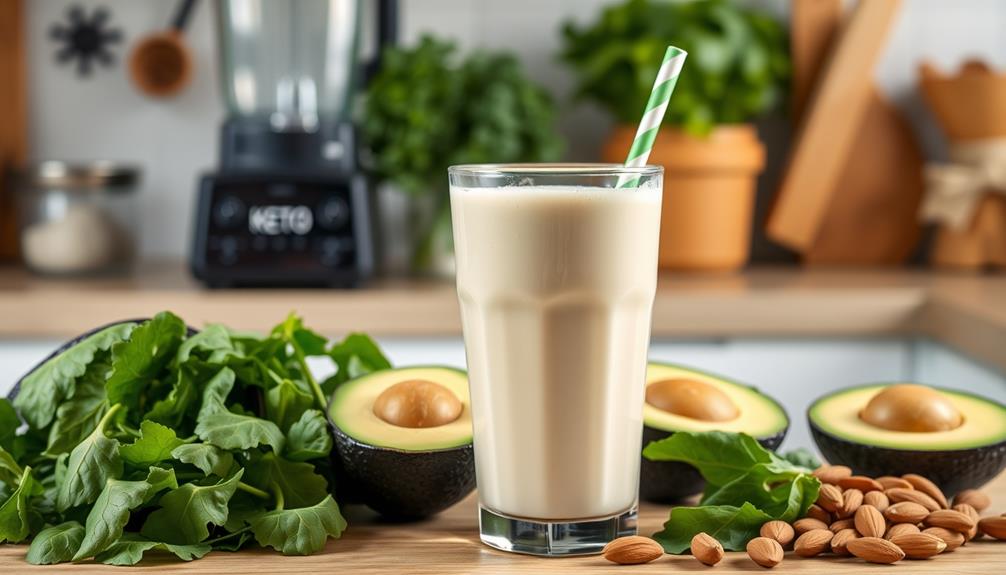To break the keto diet, you should gradually reintroduce carbohydrates over about two weeks. Start by adding 10% more carbs each day, focusing on whole foods like fruits, veggies, and grains. Keep your meals balanced with healthy fats and proteins. Avoid high-sugar and processed foods to prevent discomfort and cravings. Monitor how your body reacts to these changes by tracking your food intake and any symptoms. Staying mindful of portion sizes will also help you manage weight. If you're curious about the best foods to include and how to smoothly navigate, there's more to explore.
Key Takeaways
- Gradually reintroduce carbohydrates over 14 days, increasing intake by about 10% each day to avoid discomfort.
- Focus on whole, healthy carbs like fruits, vegetables, and whole grains to ensure nutritional balance.
- Keep a food journal to track your body's reactions to newly added foods and adjust accordingly.
- Stay hydrated and engage in regular physical activity to support your transition and maintain weight.
- Monitor portion sizes and limit added sugars to prevent spikes in blood sugar and cravings.
Understanding the Keto Diet

Many people find the keto diet appealing due to its unique approach to weight loss and metabolic health. This high-fat, low-carb dietary method restricts your carbohydrate consumption to about 20-25 grams net per day. By doing this, you induce a metabolic state known as ketosis, where your body uses fat as its primary fuel source instead of glucose.
Typically, a standard macro ratio consists of about 70-80% healthy fats, 15-25% protein, and only 5-10% carbs. However, it's important to take into account the potential impact on hydration levels, similar to the effects of a juice diet which may lead to nutrient deficiencies if not balanced.
Entering ketosis can lead to rapid weight loss and reduced appetite, but you might experience symptoms like "keto flu," which can include fatigue and headaches during the initial adjustment phase.
While this diet can be effective for many, it's crucial to be aware of potential nutrient deficiencies. The significant restriction of carbohydrate-rich foods limits your intake of fruits, vegetables, and whole grains, which are crucial for overall health.
After about six months on a strict keto diet, a gradual reintroduction of carbohydrates is advised to avoid weight regain and gastrointestinal distress. Understanding these elements can help you navigate your keto journey effectively.
Reasons for Leaving Keto

Leaving the keto diet often stems from challenges you face in social situations, where tempting high-carb options can make sticking to the plan tough.
Additionally, many individuals experience health concerns, such as digestive issues or fatigue, prompting them to reconsider their dietary choices.
Health concerns and personal goals also play a role; you might find yourself wanting to reintroduce carbs for better balance or improved wellbeing.
This desire for a more flexible diet can be influenced by various factors, including the need for effective relief from cold symptoms.
Ultimately, these factors can lead you to seek a less restrictive dietary approach.
Social Situations Challenges
Maneuvering social situations can feel like a minefield for those on the keto diet, especially when high-carb foods and sugary treats dominate the landscape. The temptation of processed foods at gatherings can make it tough to maintain your weight and stick to your plan.
You may find yourself in a situation where you need to decide between social acceptance and your keto goals. Here's a quick look at common challenges and options:
| Challenge | Options to Overcome |
|---|---|
| Temptation from high-carb foods | Bring your own keto snacks |
| Peer pressure | Focus on socializing, not food |
| Fear of missing out (FOMO) | Choose small portions of carbs |
| Events feeling restrictive | Plan ahead with keto-friendly meals |
In these moments, it's essential to remind yourself why you chose keto. While it's okay to indulge occasionally, consistently eating carbs can derail your progress. To thrive during social situations, think about how to avoid or limit those temptations without sacrificing your social life.
Health Concerns and Goals
Health concerns and personal goals often shape the decisions people make about their diets, including the keto lifestyle. If you're worried about heart disease or notice worsening lipid panels, these health concerns can lead you to reconsider your keto commitment, especially if you're at risk for cardiovascular issues.
Additionally, as you navigate your dietary choices, it's important to be aware of your credit score since financial health can also influence your ability to access nutritious food options.
After achieving your weight loss goals, you might feel tempted to reintroduce processed carbs into your diet for a more flexible eating pattern. This desire to enjoy a wider variety of foods can make the restrictive nature of keto feel challenging.
You may also realize that you're experiencing nutritional deficiencies, particularly in fiber and essential vitamins, which can impact your overall health and well-being.
When you find yourself missing out on the diverse flavors and textures of foods, it's easy to understand why many choose to break away from keto. The balance between health goals and the enjoyment of food plays a significant role in your dietary choices.
Ultimately, it's important to prioritize your well-being and find a sustainable approach that works for you.
Transitioning Off Keto

When you're ready to shift off keto, start by gradually reintroducing carbohydrates over about 14 days.
This period allows your body to adjust and helps prevent any sudden changes that might lead to discomfort. Aim to increase your carb intake by roughly 10% each day while monitoring how your body reacts to these changes.
Keeping a food journal can help you track any symptoms like bloating or fatigue during this process.
Additionally, incorporating a balanced diet rich in fruits and vegetables can support your overall health during this shift balanced diet benefits.
Gradual Carb Reintroduction
As you shift off the keto diet, gradually reintroducing carbohydrates can make the process smoother and more manageable. Aim to increase your carb intake by about 10% each day over a 14-day period. This gradual approach helps minimize blood sugar spikes and uncomfortable symptoms, while exploring best ways to earn money online can also provide a distraction during this change.
Here are some tips to keep in mind during this change:
- Focus on whole foods: Incorporate fruits, vegetables, whole grains, and legumes.
- Balance your plate: Maintain a healthy mix of healthy fats and proteins.
- Keep a food journal: Track your reactions to newly reintroduced foods.
Be cautious of sudden influxes of high-sugar foods, as they can lead to bloating, fatigue, and cravings. Instead, monitor serving sizes to make sure you're not overwhelming your system.
This balanced approach will support muscle retention and overall well-being during your carb reintroduction phase. As you navigate this adjustment, stay mindful of your body's responses and modify your choices accordingly.
Monitor Body Reactions
Monitoring your body's reactions is key while you adjust to higher carbohydrate intake after a keto diet. As you reintroduce carbs back into your meals, pay attention to any symptoms like bloating, fatigue, or gastrointestinal distress.
Keeping a food journal can be invaluable here; it'll help you track your meals and identify any adverse effects or sensitivities to specific foods. It's also important to stay informed about financial considerations for elderly care that may arise during this shift, particularly if health conditions change.
Regularly assess your energy levels and mental clarity, as these can signal how well your body is adapting. Weight changes are another critical factor to monitor. Fluctuations can indicate whether you need to adjust your carb intake or portion sizes.
Don't forget about hunger hormones; they may also shift during this shift, impacting your cravings and satiety. If you find it challenging to interpret your body's responses, consider consulting with a dietitian. They can provide tailored guidance, helping you navigate this change and guarantee you're making healthy choices.
Best Practices for Carbs

Reintroducing carbohydrates into your diet can be a delicate balance, but with the right approach, you can do it effectively. To guarantee a smooth adjustment, follow these best practices for carbs:
- Gradually increase your carb intake by about 10% daily over a 14-day period. Additionally, consider how your favorite brewing methods can impact your overall health, as certain coffee preparations may complement your dietary choices.
- Focus on whole, healthy carbohydrates like whole grains, legumes, and fruits.
- Monitor your portion sizes to prevent overeating and unwanted weight gain.
Prioritizing healthy foods will help you maintain stable blood sugar levels. Incorporate fiber-rich options, such as beans and sprouted grains, to support digestion and keep you feeling full.
Pairing carbs with healthy fats and proteins creates balanced meals that satisfy your hunger.
Don't forget to track how your body responds to new foods during this reintroduction phase. It's also wise to consult with a registered dietitian for personalized guidance on determining the right carbohydrate range, based on your activity levels and health goals.
Foods to Reintroduce

After establishing a solid foundation for incorporating carbohydrates, it's time to focus on specific foods you can welcome back into your diet.
Start with whole fruits like strawberries; they contain about 11.7g of carbs per cup and are packed with vitamin C, boosting your nutrient intake.
Additionally, incorporating fiber-rich vegetables like carrots can enhance your digestive health, as they're a good source of vitamins and minerals. A serving of baby carrots has around 7g of carbs and delivers a significant amount of vitamin A for your overall health.
For a revitalizing beverage option, consider enjoying herbal teas like chamomile or ginger, as they may also aid in relaxation during your dietary shift herbal teas for relaxation.
Legumes are another fantastic option. Incorporate black beans into your meals, which offer about 10g of carbs and are great sources of fiber and protein.
Don't forget about edamame—one cup provides approximately 13.8g of carbs along with protein and iron, supporting muscle maintenance as you shift.
Foods to Avoid

When shifting away from the keto diet, you should be mindful of certain foods that can sabotage your efforts.
Individuals with emotional dysregulation, such as those with Borderline Personality Disorder, may find it particularly challenging to manage cravings and emotional eating.
To maintain your weight and promote better health, it's crucial to avoid specific items that can disrupt your progress.
Here are some key foods to steer clear of:
- Sugary drinks: Sodas and sweetened beverages are loaded with empty calories and can cause rapid sugar spikes.
- Processed foods: These calorie-dense options often lack essential nutrients, leading to weight gain and poor health outcomes.
- Refined carbs: Foods like white bread and pastries can trigger cravings and hinder blood sugar stability.
Managing Sugar Intake

As you move away from the keto diet, managing your sugar intake becomes essential to maintaining your health and weight. It's important to limit added sugars to no more than 4 grams per serving. This helps minimize sugar spikes during your shift.
Additionally, understanding the impact of high-sugar foods, as with safe snacks for hamsters, can provide insight into healthier choices. Be cautious with naturally occurring sugars in fruits and honey; they can still greatly affect your blood sugar levels.
When you start eating carbs and sugar again, recognize that high sugar content can lead to cravings. Reading labels carefully is imperative to avoid hidden sugars in processed products.
Instead, focus on incorporating whole foods with lower sugar content, such as berries, to satisfy your sweet cravings without overdoing it.
Establishing Healthy Habits

Throughout your shift off the keto diet, establishing healthy habits is essential for maintaining your progress and overall well-being. By focusing on balanced meals that include healthy fats, lean proteins, and wholesome carbohydrates, you'll guarantee your body gets the nutrients it needs while preventing cravings and excessive hunger.
Here are some key strategies to help you along the way:
- Stay Hydrated: Drinking enough water can reduce irritability and help manage hunger.
- Create a Supportive Environment: Surround yourself with healthy food options and like-minded individuals to promote better choices.
- Prioritize Mindful Eating: Pay attention to your hunger cues and enjoy your meals without distractions.
Incorporating lifestyle changes like regular physical activity and monitoring your health metrics can further reinforce these healthy habits.
Continuous education about nutrition will also support your long-term health goals. By establishing these habits, you'll be better equipped to navigate your post-keto journey while maintaining your achievements and enjoying a balanced life.
Monitoring Your Body's Response
Monitoring your body's response after moving off the keto diet is essential for guaranteeing a smooth adjustment. As you reintroduce carbohydrates, pay close attention to how your body responds. Fluctuations in blood sugar levels can lead to unwanted symptoms like fatigue, jitters, and irritability.
Keeping a food journal helps you track reactions to newly reintroduced foods, allowing you to identify any adverse effects quickly. Be mindful of potential gastrointestinal symptoms, such as bloating or discomfort, especially when adding high-fiber foods too rapidly. This gradual approach can help minimize discomfort.
Regularly tracking weight changes during this changeover is also vital. It helps you avoid regaining lost weight and guarantees that the reintroduction process remains controlled. Consider consulting a dietitian for personalized guidance and support.
They can assist you in monitoring your body's responses effectively, helping you navigate this changeover with confidence. By being proactive and attentive, you can make informed decisions about your diet and maintain the health benefits you've gained from the keto diet.
Frequently Asked Questions
How Do I End My Keto Diet?
To end your keto diet, gradually reintroduce carbohydrates, focusing on whole foods. Monitor your body's response and adjust as needed, ensuring a balanced intake of proteins and healthy fats for overall health during the changeover.
How Do I Break Out of Keto?
To break out of keto, gradually increase your carb intake by 10 grams each day. Focus on whole foods, monitor your body's response, and consider consulting a dietitian for tailored guidance during this shift.
How to Break a Keto Fast Properly?
Imagine gently waking a sleeping giant. To break your keto fast properly, start with small portions of bone broth or smoothies, then gradually introduce proteins and fibers, ensuring your body eases back into regular eating.
How Do I Cycle off My Keto Diet?
To cycle off your keto diet, gradually increase carbs by 10g daily, focus on whole foods, monitor your body's reactions, decrease fats, and consider consulting a dietitian for personalized advice tailored to your needs.
Conclusion
Breaking the keto diet doesn't have to feel like climbing a mountain. By understanding your body's needs and reintroducing carbs mindfully, you can shift smoothly without derailing your progress. Think of it as a dance—take it step by step, focusing on balance. Keep an eye on your body's reactions and prioritize healthy choices. Ultimately, it's about finding what works for you and enjoying the journey towards a more flexible lifestyle.









